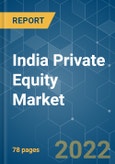The Indian private equity market is projected to register a CAGR of approximately 15% during the forecast period. The share of India in the global private investment market was valued at 2.2% during the period between 2015 and 2017. In 2019, significant investments in the infrastructure sector, which accounted for 35% of all private equity investments in India in 2019, provided momentum to the Indian private equity investment activity. The infrastructure sector witnessed rising demand for global buyouts and pension and sovereign funds. Furthermore, this trend is expected to remain strong in the near future. From a sector point of view, infrastructure (USD 803 million), real estate (USD 764 million), and financial services (USD 734 million) were the top three sectors, in terms of private equity investments, as of August 2019. Investments in the infrastructure and real estate sectors accounted for 35% of the total private equity investments in August 2019, as compared to 23% in August 2018. In 2019, the major deals included purchase of 9% stake in SBI Life Insurance by Carlyle Group, for about USD 652 million. This is one of Carlyle Group’s significant investments in India. Other significant deals included Baring Private equity purchase in NIIT Technologies and Brookfield Asset Management’s purchase of Pipeline Infrastructure. The infrastructure sector accounted for majority of the share in private equity investment, as of August 2019. Furthermore, Government of Singapore Investment Corp. invested in IRB Infrastructure's build-operate-transfer assets, for USD 622 million. Moreover, this deal is considered as one of the primary investments in the infrastructure sector, by a single sovereign wealth fund. The consumer tech and banking, financial services, and insurance (BFSI) remained the largest industrial sectors for investment, in terms of value. BFSI (banking, financial services, and insurance) remained the dominant industrial sector, with investments worth more than USD 5 billion in 2018. This was primarily driven by the rising class of non-banking financial companies (NBFCs), which impacted the growth of the ecosystem.
Key Market Trends
Increase in the Value of Private Equity Deals, Y-O-Y
In 2018, the Indian private equity market witnessed about 793 deals, which were valued at USD 26 billion. This investment value was the second highest in the last decade. Moreover, private equity funds are focusing on prioritizing deal quality over quantity, with the top 15 deals comprising about 40% of the total deal value and numerous deals were worth more than USD 50 million. The market remained strong, indicating investor confidence in the Indian market. In 2018, nearly half of the exit value resulted from the sale of Flipkart to Walmart, which was worth USD 16 billion. However, even after excluding that, 2018 was one of the best years for exits in the past decade. In the Asia-Pacific region, diversified fundraising had slowed down, as a result of the Chinese government's decision to tighten rules on private equity investment. However, India-focused dry powder remained healthy at USD 11.1 billion.
Private Equity Investment in the Indian Commercial Real Estate is an Uptrend
Several private equity players, such as Xander, Blackstone, and Brookfield, are primarily focusing on the Indian real estate industry, especially the commercial segment, with several transactions recorded in the country in 2018. The business and companies, both, multinational and domestic, witnessed expansion. There have been several developments in the Indian market, such provision of the infrastructure status to the logistics sector, allowance of 100% FDI in the e-commerce market, and comprehensive tax reforms, like the Goods and Services Tax (GST). Such developments boosted the prospects of investment in the Indian commercial real estate market. Private equity investors were focusing on investing in commercial, affordable housing, logistics, and warehousing, due to steady rentals and rental yield. Furthermore, increase in the number of buyouts was the primarily that aided the investments in the private equity market.
Competitive Landscape
The report provides an overview of the major players in the Indian private equity market, which is fragmented. It includes, both, local and international players. The private equity players are primarily investing in real estate, BFSI, and healthcare.
Additional Benefits:
- The market estimate (ME) sheet in Excel format
- 3 months of analyst support
This product will be delivered within 2 business days.








